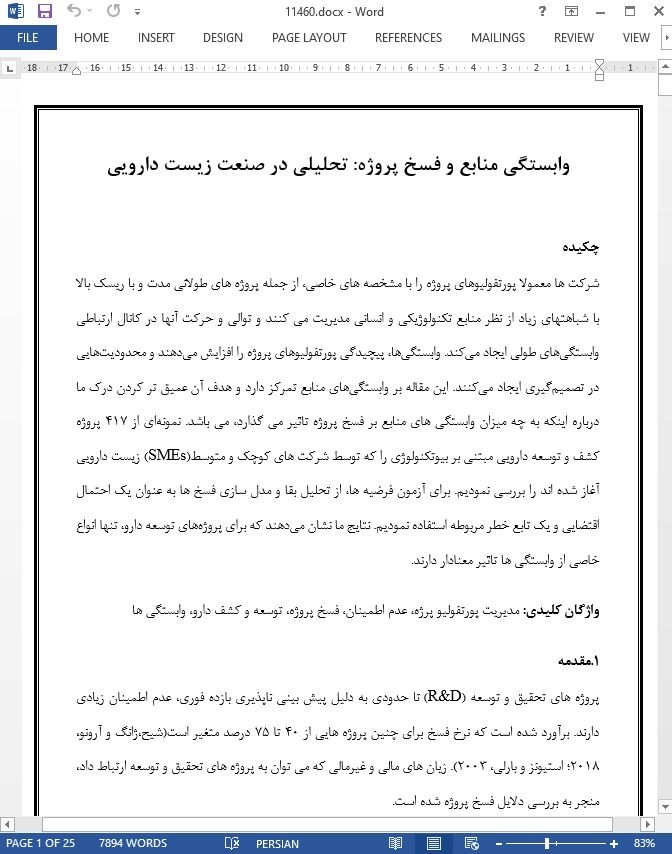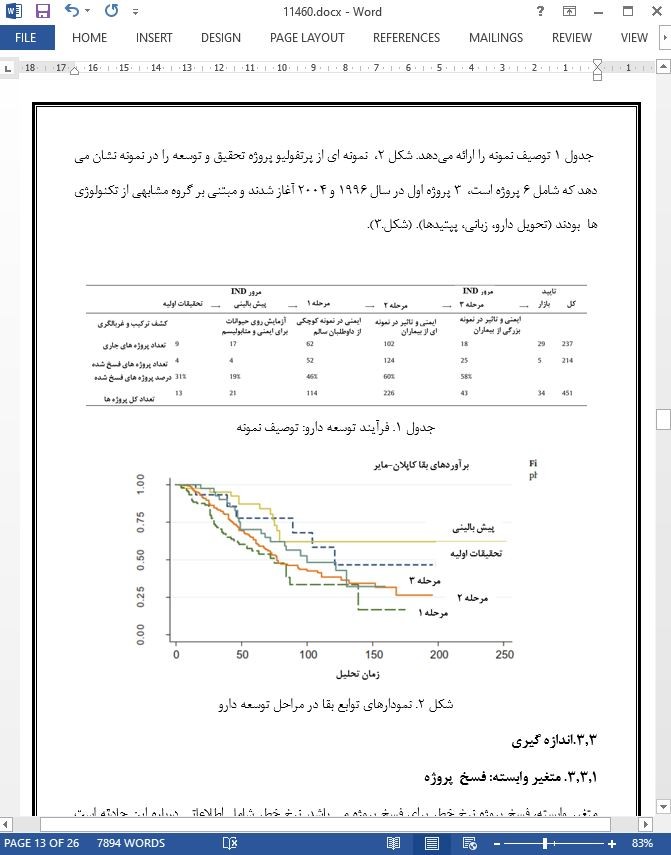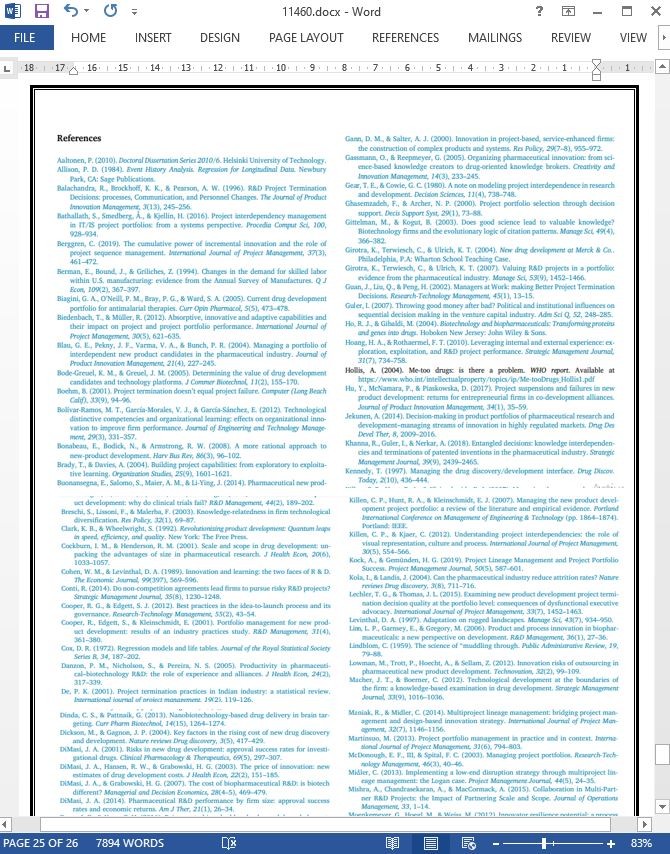
وابستگی منابع و فسخ پروژه: تحلیلی در صنعت زیست دارویی
چکیده
شرکت ها معمولا پورتفولیوهای پروژه را با مشخصه های خاصی، از جمله پروژه های طولانی مدت و با ریسک بالا با شباهتهای زیاد از نظر منابع تکنولوژیکی و انسانی مدیریت می کنند و توالی و حرکت آنها در کانال ارتباطی وابستگیهای طولی ایجاد میکند. وابستگیها، پیچیدگی پورتفولیوهای پروژه را افزایش میدهند و محدودیتهایی در تصمیمگیری ایجاد میکنند. این مقاله بر وابستگیهای منابع تمرکز دارد و هدف آن عمیق تر کردن درک ما درباره اینکه به چه میزان وابستگی های منابع بر فسخ پروژه تاثیر می گذارد، می باشد. نمونهای از ۴۱۷ پروژه کشف و توسعه دارویی مبتنی بر بیوتکنولوژی را که توسط شرکت های کوچک و متوسط(SMEs) زیست دارویی آغاز شده اند را بررسی نمودیم. برای آزمون فرضیه ها، از تحلیل بقا و مدل سازی فسخ ها به عنوان یک احتمال اقتضایی و یک تابع خطر مربوطه استفاده نمودیم. نتایج ما نشان میدهند که برای پروژههای توسعه دارو، تنها انواع خاصی از وابستگی ها تاثیر معنادار دارند.
1.مقدمه
پروژه های تحقیق و توسعه (R&D) تا حدودی به دلیل پیش بینی ناپذیری بازده فوری، عدم اطمینان زیادی دارند. برآورد شده است که نرخ فسخ برای چنین پروژه هایی از ۴۰ تا ۷۵ درصد متغیر است(شیح،ژانگ و آرونو، 2018؛ استیونز و بارلی، 2003). زیان های مالی و غیرمالی که می توان به پروژه های تحقیق و توسعه ارتباط داد، منجر به بررسی دلایل فسخ پروژه شده است.
بیشتر تحلیل های فسخ پروژه بر پروژه های فردی تمرکز دارد(بیدنباخ و مولر، 2012؛ آنگر، کاک، گاموندن و جوناس، 2012). آنها نشان دادهاند که تعیین عوامل فسخ پروژه تحقیق و توسعه مرتبط با پارامترهای مانند سرمایه گذاری هایی با ریسک بالا(کانتی، 2014؛ پامولی، ماگوزینی و ریکابونی، 2011)، عدم ایجاد دانش قابل استفاده (بانابو، بودیک و آرمسترانگ، 2008)، عدم توانایی شرکت برای بهره برداری از کشف آن و استفاده از تجربه برای پروژه تحقیق و توسعه (هوآنگ و راترمال، 2010)، ساختار همکاری (مانند میشرا، کاندراسکاران و مک کورماک، 2015؛ پیسانو، 1997)، موقعیت شرکت در شبکه دانش میان شرکتی(دانگ و یانگ، 2016) و به طور کلی تر، ویژگی های پروژه است و دلایل فسخ با توجه به نوع پروژه متغیر است(پینتو و مانتل، 1990).
6.1. کاربردهای مدیریتی
صنعت زیست دارویی میتواند به عنوان مدلی برای شرکت ها در سایر صنایع عمل کند، که دارای عوامل اقتضائی مشابه در محیط رقابتی و بسیار پویا هستند. همانگونه که خانا و همکاران (2018) بیان میکنند، فسخ ها ممکن است برای شکلگیری پورتفولیو های نوآورانه، استراتژیک باشد: " وابستگی ها در جستجوی پرتفولیو ها ممکن است نه تنها بر اثربخشی جستجو تاثیر بگذارد، بلکه می تواند بر استراتژی های انتخاب شرکت ها نیز تأثیرگذار باشد" (2018، ص.2459). نتایج مطالعه موجود بینش جدیدی درباره شیوه های مدیریت پروژه ارائه میدهد. به مدیران پیشنهاد می شود رویکرد پویایی اتخاذ کنند و مدیریت پورتفولیو پروژه را با مدیریت سابقه پروژه ترکیب کنند. یعنی تصمیمات مربوط به ساختار پرتفولیو پروژه نباید تنها وابستگی های پروژه را در یک لحظه خاص در نظر گیرد. به خاطر اینکه پروژه ها در طی زمان تکامل مییابند، به ایجاد سیستمهای مدیریت دانش در حال تکامل نیاز دارند، مانند استفاده از یادگیری برای پروژههای قبلی(کاک و گماندن، 2019)، جهت بهینهسازی سرمایهگذاریها در پروژه های آتی. همچنین، مدیران باید ظرفیت اکتشافی شرکت را بسازند، بنابراین میتوانند از تکنولوژی های جدید برای پروژههای بعدی استفاده کنند.
Abstract
Firms typically manage project portfolios with specific characteristics, including lengthy and high-risk projects with many similarities in human and technological resources and whose sequence and movement through the pipeline create longitudinal interdependencies. Interdependencies increase the complexity of project portfolios and create constraints in decision-making. This paper focuses on resource interdependencies and aims deepen our understanding of the extent to which resource interdependencies affect project termination. We study a sample of 417 new biotechnology-based drug discovery and development projects initiated by 25 biopharmaceutical SMEs. To test the hypotheses, we employ survival analysis and model terminations as a conditional probability and a corresponding hazard function. Our results show that for drug development projects, only certain types of interdependencies have a significant effect.
1. Introduction
R&D projects involve a high degree of uncertainty due in part to the unpredictability of immediate returns. The termination rate for such projects has been estimated to range from 40 to 75% (Shih, Zhang, & Aronov, 2018; Stevens and Burley, 2003). The significant financial and non-financial losses that can be associated with R&D projects warrant a study on the reasons for project termination.
Most analyses of project termination focus on individual projects in isolation (Biedenbach and Müller, 2012; Unger, Kock, Gemünden, and Jonas, 2012). They have shown that the determining factors for R&D project termination relate to parameters such as high-risk investments (Conti, 2014; Pammolli, Magazzini, and Riccaboni, 2011), lack of exploitable knowledge created (Bonabeau, Bodick, & Armstrong, 2008), the firm’s inability to leverage its exploration and exploitation experience for R&D projects (Hoang and Rothaermel, 2010), the collaboration structure (e.g., Mishra, Chandrasekaran, and MacCormack, 2015; Pisano, 1997), the firm’s position in an interfirm knowledge network (Dong and Yang, 2016), and more generally, the project’s characteristics, with the causes of termination varying by project type (Pinto and Mantel, 1990).
6.1. Managerial implications
The biopharmaceutical industry may serve as a model for firms in other industries that share the same contingencies in a highly dynamic and competitive environment. As Khanna et al. (2018) points out, terminations can be strategic for shaping innovative portfolios: “Interdependencies in research portfolios may influence not only the effectiveness of search, but also firms’ selection strategies” (2018, p. 2459). The results of the present study offer new insights into project portfolio management practices. Managers are recommended to adopt a dynamic perspective and to combine project portfolio management with project lineage management. This means that decisions about the project portfolio structure need to consider more than just project interdependencies at a given moment. Because projects evolve over time, they require the development of evolving knowledge management systems, such as using learnings from past projects (Kock and Gemünden, 2019) in order to optimize investments in future projects. At the same time, managers should build the firm’s exploration capacity so it can leverage new technologies for subsequent projects.
چکیده
1.مقدمه
2.فسخ و وابستگیهای پروژه
2.1. وابستگی های تکنولوژی متمرکز و فسخ پروژههای تحقیق و توسعه
2.2. وابستگی های طولی و فسخ پروژه تحقیق و توسعه
2.3. وابستگی های متقابل و فسخ پروژه تحقیق و توسعه
3. روش
3.1. زمینه پروژه توسعه دارو
3.2. داده ها
3.3.اندازه گیری
4. تحلیل
5. نتایج
6.بحث و نتیجه گیری
6.1. کاربردهای مدیریتی
Abstract
1. Introduction
2. Termination and project interdependencies
2.1. Pooled technology interdependencies and termination of r&d projects
2.2. Longitudinal interdependencies and r&d project termination
2.3. Reciprocal interdependencies and r&d project termination
3. Methodology
3.1. The drug development project context
3.2. Data
3.3. Measurement
4. Analysis
5. Results
6. Discussion and conclusion
6.1. Managerial implications
- ترجمه فارسی مقاله با فرمت ورد (word) با قابلیت ویرایش، بدون آرم سایت ای ترجمه
- ترجمه فارسی مقاله با فرمت pdf، بدون آرم سایت ای ترجمه



